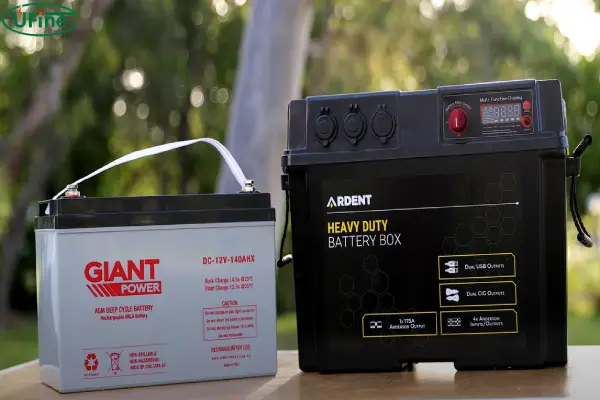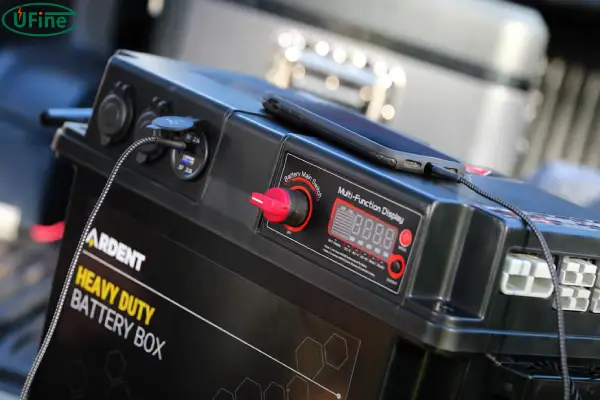You’ve got a battery. But what about a safe and secure place to store it? That’s where a battery box comes in. It’s like a special house for your battery, protecting it from the elements and keeping things safe. Let’s dive into the world of battery boxes and see what makes them so important.
Part 1. Battery box composition
A battery box isn’t just a simple box; it’s a carefully engineered system designed to safeguard your battery and ensure its smooth operation. Let’s break down its key components:
-
The Enclosure: The heart of the battery box is its sturdy enclosure. This is where the magic happens, protecting your battery from the elements and keeping everything secure. Materials like plastic, metal, or fiberglass are commonly used, each offering its own strengths in terms of durability, weather resistance, and cost.
-
Battery Terminals: These are the crucial connection points where your battery links to the rest of your system. The battery box keeps these terminals organized and protected, preventing accidental short circuits and ensuring a reliable connection. Often, the box will incorporate features like terminal covers or protective shrouds to further enhance safety.
-
Ventilation: Batteries, especially lead-acid types, can release gases during charging and operation. Ventilation holes are essential to allow for proper airflow, preventing the buildup of harmful gases and ensuring a safe environment. These holes are strategically placed to maximize airflow while minimizing the risk of external elements entering the box.
-
Mounting Brackets: These are the unsung heroes of the battery box, securely holding the battery in place. They prevent the battery from shifting or moving during operation, reducing the risk of damage and ensuring a stable connection. The mounting brackets are designed to be compatible with the specific battery type and size, ensuring a secure fit.
-
Additional Features: Some battery boxes go beyond the basics, offering extra features to enhance functionality and safety. These can include:
- Fuses or Circuit Breakers: These provide an additional layer of protection, preventing excessive current flow and potential damage to your battery or system.
- Built-in Chargers: Some battery boxes incorporate a built-in charger, simplifying the charging process and eliminating the need for separate charging equipment.
- Temperature Monitoring: This feature is particularly important for lithium-ion batteries, which are sensitive to temperature fluctuations. Temperature monitoring helps ensure the battery stays within its safe operating range, extending its lifespan.
- Balancing Circuits: For lithium-ion batteries, balancing circuits ensure that each cell in the battery pack charges evenly, maximizing the battery’s lifespan and performance.
Part 2. Battery box function
Battery boxes are essential for ensuring the safety, longevity, and optimal performance of your battery. Here’s a deeper look at their crucial functions:
-
Protection from the Elements: Batteries are sensitive to the elements. Rain, snow, dust, extreme temperatures, and even UV rays can damage a battery, shortening its lifespan and potentially causing safety hazards. A battery box acts as a shield, protecting your battery from these environmental aggressors and ensuring it remains in optimal condition.
-
Enhanced Safety: Batteries can release harmful gases, especially during charging. These gases can be flammable, posing a fire hazard. A battery box keeps these gases contained, preventing them from escaping and creating a safer environment. Additionally, the box’s sturdy construction helps prevent accidental contact with the battery terminals, reducing the risk of electrical shocks.
-
Organized and Accessible: A battery box keeps your battery terminals organized and easily accessible. This makes it easier to connect and disconnect your battery, reducing the risk of accidental short circuits and ensuring a reliable connection. The box also helps prevent corrosion on the terminals, maintaining optimal conductivity.
-
Durability and Stability: A good battery box is built to withstand the rigors of everyday use. It can handle bumps, vibrations, and even rough terrain, protecting your battery from damage and ensuring a stable power source. The box’s sturdy construction also helps prevent the battery from shifting or moving during operation, maintaining a secure connection and preventing potential problems.
Part 3. Battery box type
Battery boxes are not a one-size-fits-all solution. They come in a variety of shapes, sizes, and materials, each designed for specific applications and battery types. Here’s a breakdown of some common types:
-
Lead-Acid Battery Boxes: These are designed for traditional lead-acid batteries, which are still widely used in various applications. They are often made from durable plastic or metal and feature ventilation holes to prevent the buildup of gases. These boxes are typically more affordable than their counterparts for newer battery technologies.
-
AGM Battery Boxes: These boxes are specifically designed for AGM (Absorbed Glass Mat) batteries, which offer improved performance and safety compared to standard lead-acid batteries. They often feature enhanced leak-proof designs and may incorporate additional features like temperature monitoring.
-
Lithium Battery Boxes: These boxes are tailored for lithium-ion batteries, which are becoming increasingly popular due to their high energy density, long lifespan, and lightweight design. Lithium battery boxes often have more advanced features like temperature monitoring, balancing circuits, and specialized ventilation systems to ensure optimal performance and safety for these sensitive batteries.
-
Deep Cycle Battery Boxes: These boxes are specifically designed for deep cycle batteries, which are commonly used in applications requiring extended run times, such as solar energy systems, electric vehicles, and marine applications. They often feature robust construction, and enhanced ventilation, and may incorporate features like built-in chargers or battery management systems.
-
Marine Battery Boxes: These boxes are designed for marine applications, where batteries are exposed to harsh environments like saltwater, humidity, and vibration. They are typically made from corrosion-resistant materials like stainless steel or fiberglass and feature sealed designs to protect the battery from the elements.
Part 4. Battery box application
Battery boxes are essential components in a wide range of applications, ensuring the safe and reliable operation of batteries in diverse environments. Here are some common examples:
-
Automotive: Cars, trucks, motorcycles, and even golf carts utilize battery boxes to protect their batteries from the elements and ensure a stable power source. The boxes are typically located under the hood or in the trunk, providing a secure and protected environment for the battery.
-
Solar Energy Systems: Off-grid solar systems rely on battery boxes to protect their batteries and ensure a reliable power supply. The boxes are often located in a designated area, providing a secure and weather-resistant environment for the batteries.
-
Marine Applications: Boats and yachts use battery boxes to keep their batteries safe from the harsh marine environment, including saltwater, humidity, and vibration. The boxes are typically made from corrosion-resistant materials and feature sealed designs to protect the battery from the elements.
-
Industrial Equipment: Forklifts, cranes, and other industrial equipment often utilize battery boxes to protect their batteries from damage and ensure a reliable power source. The boxes are typically designed to withstand heavy loads, vibrations, and harsh working conditions.
-
Medical Equipment: Battery boxes are also used in medical equipment, such as wheelchairs, oxygen concentrators, and portable medical devices. They ensure the safe and reliable operation of the batteries, providing essential power for critical medical applications.
-
Telecommunications: Battery boxes are used in telecommunications equipment, such as cell towers and network switches. They provide a secure and reliable power source for these critical systems, ensuring continuous communication even during power outages.
Part 5. Do I need a battery box?
Whether or not you need a battery box depends on your specific situation and the type of battery you’re using. Here are some factors to consider:
-
Battery Type: Some battery types, like lead-acid batteries, are more prone to leaks and spills. A battery box can help prevent these issues and ensure a safer environment.
-
Environment: If your battery is exposed to the elements, a battery box is essential for protection. It will shield the battery from rain, snow, dust, extreme temperatures, and other environmental hazards.
-
Safety: If your battery is located in a high-traffic area or near flammable materials, a battery box can help improve safety by containing potential hazards.
-
Durability: If your battery is subjected to vibrations or bumps, a battery box can help protect it from damage and ensure a stable power source.
-
Battery Size and Weight: For larger and heavier batteries, a battery box can provide a secure and stable mounting solution, preventing the battery from shifting or moving and potentially causing damage.
Part 6. Buy a battery box: key considerations
When selecting a battery box, there are several factors to consider to ensure you choose the right one for your needs:
-
Battery Size: The battery box must be large enough to accommodate your battery, with sufficient space for proper ventilation and secure mounting.
-
Battery Type: Choose a battery box designed for the specific type of battery you’re using. This ensures compatibility with the battery’s dimensions, terminal configuration, and any specific requirements for ventilation or safety features.
-
Materials: Consider the materials the battery box is made from. Look for durable and weather-resistant options that will withstand the intended environment. Common materials include plastic, metal, fiberglass, and stainless steel, each offering its own advantages in terms of durability, corrosion resistance, and cost.
-
Features: Some battery boxes offer additional features that can enhance functionality and safety. These include:
-
Ventilation: Adequate ventilation is crucial for preventing the buildup of gases and ensuring a safe environment. Look for boxes with strategically placed ventilation holes and consider the size and placement of the holes based on the battery type and application.
-
Mounting Brackets: Secure mounting brackets are essential for holding the battery in place and preventing it from shifting or moving during operation. Consider the design and strength of the brackets, ensuring they are compatible with your battery and application.
-
Fuses or Circuit Breakers: These provide an additional layer of protection, preventing excessive current flow and potential damage to your battery or system. Consider the amperage rating of the fuses or circuit breakers, ensuring they are appropriate for your battery and application.
-
Built-in Chargers: Some battery boxes incorporate a built-in charger, simplifying the charging process and eliminating the need for separate charging equipment. Consider the charging capacity and features of the built-in charger, ensuring it meets your needs.
-
Temperature Monitoring: This feature is particularly important for lithium-ion batteries, which are sensitive to temperature fluctuations. Temperature monitoring helps ensure the battery stays within its safe operating range, extending its lifespan. Look for boxes with accurate temperature sensors and appropriate temperature control mechanisms.
-
Balancing Circuits: For lithium-ion batteries, balancing circuits ensure that each cell in the battery pack charges evenly, maximizing the battery’s lifespan and performance. Consider the design and capabilities of the balancing circuit, ensuring it is compatible with your battery and application.
-
-
Price: Battery boxes come in a range of prices, depending on their size, materials, features, and brand. Set a budget and compare prices from different manufacturers, considering the value proposition and the features that are most important for your needs.
Part 7. Is it safe to put the battery in the battery box?
While battery boxes are designed to enhance safety, it’s essential to follow some guidelines to ensure a safe and reliable operation:
-
Battery Compatibility: Always ensure that the battery box is designed for the specific type of battery you’re using. Using the wrong type of box can lead to compatibility issues, potential damage to the battery, and safety hazards.
-
Secure Connections: Double-check that the battery terminals are properly connected and secured within the battery box. Loose connections can lead to electrical resistance, heat buildup, and potential damage to the battery or system.
-
Ventilation: Ensure that the battery box has adequate ventilation to prevent the buildup of heat and gases. Proper ventilation is crucial for maintaining a safe environment and preventing potential hazards.
-
Manufacturer’s Instructions: Always follow the manufacturer’s instructions for using and maintaining the battery box. These instructions provide valuable information on proper installation, operation, maintenance, and safety precautions.
-
Regular Inspection: Periodically inspect the battery box for signs of damage, corrosion, or loose connections. Promptly address any issues to ensure continued safety and reliability.
Part 8. How long can the battery be kept in the battery box?
A battery box, when properly maintained, can last for many years. However, its lifespan depends on several factors:
-
Material Quality: The materials used in the battery box’s construction play a significant role in its durability. High-quality materials, like corrosion-resistant metals or UV-resistant plastics, will withstand the elements and last longer.
-
Environmental Conditions: The environment in which the battery box is used can impact its lifespan. Exposure to harsh weather conditions, extreme temperatures, or corrosive elements can accelerate wear and tear.
-
Usage and Maintenance: Regular inspection, cleaning, and proper maintenance can extend the lifespan of a battery box. Addressing any issues promptly, such as corrosion or loose connections, can prevent further damage and ensure continued safety and reliability.
Part 9. Conclusion
Battery boxes are often overlooked, but they play a crucial role in ensuring the safety, longevity, and optimal performance of your battery. By understanding their design, functions, types, and safety considerations, you can choose the right battery box for your needs and keep your power source running smoothly for years to come. So, next time you think about your battery, remember the unsung hero that protects it – the battery box
Related Tags:
More Articles

How to Choose the Best Floor Scrubber Battery for Commercial Cleaning?
Selecting the ideal floor scrubber battery ensures a long runtime, rapid charging, and minimal maintenance for efficient commercial cleaning operations.
Battery for Blower vs Battery for Leaf Vacuum: Which One Should You Choose?
Battery for blower vs leaf vacuum—learn the key differences in power, fit, and runtime to choose the right battery for your outdoor tool needs.
How to Choose the Right Battery for Blower?
Choosing the right blower battery? Consider voltage, capacity, chemistry & usage. This guide helps match the best battery for peak performance.
How to Choose the Best Insulated Battery Box for Lithium Batteries?
Choosing the Best Insulated Battery Box for Lithium Batteries? Discover key factors such as size, material, and safety for optimal protection and performance.
7 Critical Elements on a Lithium Battery Shipping Label
What must be on a lithium battery shipping label? Learn 7 key elements to ensure safety, legal compliance, and correct handling across all transport modes.





